STUDY OF CHLOROPHYLL-A DISTRIBUTIONS IN LOMBOK STRAIT USING BIOGEOCHEMICAL MODEL BASED ON REGIONAL OCEAN MODELLING SYSTEM (ROMS)
on
ECOTROPHIC • 6 (1) : 31 - 36
ISSN : 1907-5626
STUDY OF CHLOROPHYLL^A DISTRIBUTIONS IN LOMBOK STRAIT USING BIOGEOCHEMICAL MODEL BASED ON REGIONAL OCEAN MODELLING SYSTEM (ROMS)
KADekARy Anggreni 1)2), Takahiro Osawa 2), lWAYANARTHANA 3)
1) School of Bwlogy Science, Udayana University
2! Center for Remote Sensing and Ocean Sciences (CReSOS) Udayana Unwersity 3! Environmental Research Ccnte1; Udayana University
ABSTRAK
Regional Ocean Modelling System atau Sistem Pemodelan Laut Regional (ROMS) telah digunakan untuk bermacam keperluan, bermacam pemodelan kelautan. Model Biogeokimia yang dipasangkan dengan ROMS terdiri dari tujuh pasang bagian persamaan yang berbeda-beda mencakup: nitrat, amonium, detritus kecil dan besar, fitoplankton, zooplankton, dan karbon fitoplankton yang dinamis menjadi suatu rasio klorofi.1. Studi pola penyebaran klorofil-a di Selat Lombok (-7 °N - -10 °5 dan 114 °E - 117 °E) pada tahun 2006 telah dianalisis menggunakan model Biogeokimia berdasar pada ROMS.
Hasil penelitian menunjukkan bahwa sebaran klorofil-a teramati rendah (0,20 mgChl-a/m3) di Selat Lombok pada bulan Januari. Klorofil-a diperkirakan di bagian sebelah selatan Selat Bali dan penyebaran klorofil-a rendah pada lapisan atas dari Selat Lombok.
Klorofil-a berlimpah (0,32 mgChl-a/m3) teramati di bulan Agustus. Arah arus timur laut bergerak kearah barat clan bagian selatan di daerah penelitian melalui Selat Lombok. Konsentrasi klorofil-a tertinggi diperkirakan di sebelah utara hingga bagian barat daya Pulau Bali clan juga di bagian selatan Pulau Lombok. Selama musim kering, angin arah tenggara berhembus dari Australia memicu terjadinya proses upwelling (temperatur rendah clan air yang kaya nutrien di dekat permukaan) juga diperkirakan berdasarkan ROMS.
Kata kunci: model Biogeokimia, Sistem Pemodelan Laut Regional, sebaran klorojil-a, proses upwelling
ABSTRACT
Regional Ocean Modelling System (ROMS) has been intended to be a multi-purpose, multi-disciplinary oceanic modeling tool. The Biogeochemical model have coupled to ROMS consists of a system ofseven coupled partial differential equations that include: nitrate, ammonium, small and large detritus, phytoplankton, zooplankton, and a dynamic phytoplankton carbon to chlorophyll ratio. The study ofdistribution patterns ofchlorophyll-a in Lombok Strait (-7 °N - -10 °S and 114 °E - 117 °E) in 2006 was analyzed using the Biogeochemical model based on ROMS.
The results show that low chlorophyll-a distributions (0.20 mgChl-a/m3) observed in Lombok Strait in January. Chlorophyll-a estimated around the southern part of Bali Strait and low chlorophyll-a distribution in upper layer of the Lombok Strait.
Chlorophyll-a ofthe booming (0.32 mgChl-a/m 3) observed in August. The northeast current direction moves to the west and southern part of research area through Lombok Strait. The highest chlorophyll-a concentration estimated in the northern and southwestern part of Bali Island and also in the southern part of Lombok Island. During dry monsoon, southeasterly wind blow from Australia generates upwelling process (low temperature and nutrient-rich water near the surface) also estimated from ROMS.
Keywords: Biogeochemical model, Regional Ocean Modelling System, chlorophyll-a distributions, upwelling process
INTRODUCTION
Chlorophyll plays an important role in plants in the photosynthesis, the mechanism by which plants acquire energy. In the photosynthesis process, all plants, including phytoplankton in the ocean, absorb C02, so the ocean plays an important role in adjusting the C02 concentration in the atmosphere. Ocean biogeochemical and ecosystem processes are linked by Net Primary
Production (NPP) in the ocean's surface layer, where inorganic carbon is fixed by photosynthetic processes (Behrenfeld, et al., 2005).
The vertical distribution patterns of chlorophyll concentration depend on seasons and regions. The chlorophyll maximum value is not always observed near or at the sea surface, but sometimes lies deeper than the bottom of the eupothic zone. In this case, the ocean color sensors cannot measure the chloro-
phyll maximum value (Parson et al., 1984 in Pertami, 2006).
Coastal environments are important biogeochemical pathways between land and the open ocean that significantly modify the flows of matter and energy between the latter two systems. They receive and exchange considerable amounts of dissolved and particulate organic matter and nutrients, freshwater, energy and contaminants (Smith and Hollibaugh, 1993; Gattuso et al., 1998; Wollast, 1998 in Schiettecatte, 2006).
In this study, the changes in the vertical distribution of chl-a concentration from the sea surface in Lombok strait were investigate using biogeochemical model based on Regional Ocean Modelling System (ROMS).
Tlie first aim of this research is to know the change of the vertical distribution of chl-a concentration from the sea surface using ROMS with Biogeochemical Model. The second aim is to estimate the distribution of chl-a in Lombok Strait concerning with ITF and monsoon.
The result of this research can be giving an understanding of how the changed of the vertical distribution of chl-a concentration from the sea surface using ROMS with Biogeochemical Model and the distribution of chl-a in Lombok Strait concerning with ITF and monsoon.
RESEARCH METHODOLOGY
The research was conducted in Lombok Strait (-7 oN ~ -10 oS and 114 0E ~ 117 oE). In-situ data recorded such as temperature, salinity, turbidity, chlorophyll concentration, and sigma-T (density) by COMPACT-CTD. In this study, the observed data (chl-a concentration, temperature, and salinity) are employed for the validation.
The satellite data from SeaWIFS (Sea-viewing Wide Field-of-view Sensor) were used in January to December 2006 for inputting directly into the biogeochemical model. The ocean color reveals information on the presence and concentration of phytoplankton, sediments, and dissolved organic matters of the ocean. Tlius, SeaWiFS can manage the marine environment (Chaomin et al., 2001).
The bathymetry data was taken from ETOPO-2. The data is a combination of satellite altimetry observations, shipboard echo-sounding measurements, data from the Digital Bathymetric Data Base Variable Resolution and data from the GLOBE project which has a global digital elevation model (SOS NOAA, 2009).
The surface forcing data such as wind stress, long wave and short wave radiation, evaporation, and precipitation are from NCEP (National Centers for Environmental Prediction). All of the data were analyzed
using ROMS. Finally, the model results compared to the in-situ data set and satellite data. The research scheme
Data was analyzed using the Biogeochemical model of the ROMS (Moisan et al., 2001). Tlie model equations is as the following:
^y^ = '^, (ft +Q, H%'o1-'∕wH'TlL ∣pλ>,'T^J⅛1+^ (4.i) ∂[Zoo] _ n∙[Zoo]-t2. [Zoo]-t7 [Zoo]-01.r.[Zoo]
^^¼.w([SD<7ΛJ÷[^∙^ 1PA>7λ])-∕,λ,m,RDwΛ'J+Δ, (45)
⅛J = -', -P, [P>>v∣l,]-Q., [N J+(r^ + β^4‰]+⅛.-∫∞rtΛ'∣+^__Ju⅛w](4i4)
Resultand discussion
Bathimetry map (the average depth 200 - 300 meters) is shows in Figure 1. In the northern strait, there is a deep channel with depth up to 1400 m. There is an ocean trench found in the northern part of Lombok Strait with depth is more than 1500 m (showed by light blue color) then Java sea in the southern part with depth is up to 1000 m (showed by navy blue color). The southern part of Lombok strait is the Indian ocean with depth around 500 - 4000 m (showed by different color in each water depth area).
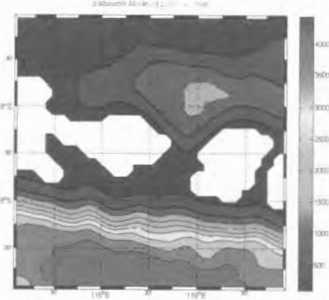
Figure 1 Bathimetry model of Lombok Strait

Figure 2 (a) Chl-a distribution in January from model

Figure 2 (c) Chl-a distribution in January from satellite

03 Df
Figure 2 (b) Chl-a distribution in August from model
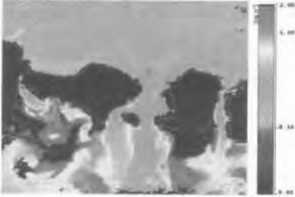
Figure 2 (d) Chl-a distribution in August from satellite
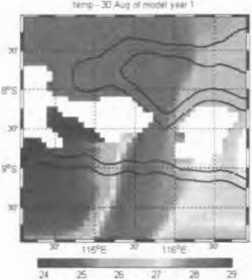
Figure 3 (b) Distribution patterns of temp, in August from model
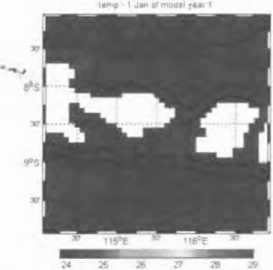
Figure 3 (a) Distribution patterns of temp, in January from model
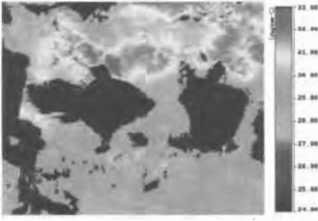

Figure 3 (c) Distribution patterns of temp, in January from satellite
Figure 3 (d) Distribution patterns of temp, in August from satellite
During rainy season, the northwest current direction moves to the east and southern part through the Lombok Strait in January The highest chl-a values only estimated in the small area in the northwestern part of Java island and the lowest values (blue) estimated in the almost research area included the Lombok Strait. The maximum value of chl-a is 0.6 (mgChl-a/m3) and the minimum value is 0.1 (mgChl-a∕m3). The results derived from the model indicated that low chl-a distributions at the sea surface in Lombok Strait in January (Figure 2 (a)). The chl-a distribution is around 0.2 (mgChl-a∕m3). Many rivers change the value bring nutrients enter into the strait in coastal area. In the month (when the northwest monsoon happened), northwesterly wind drives the surface current to the east and southward and accumulates the warm water in the southeastern part of Lombok Strait to the Indian ocean.
During dry season, the northeast current direction moves to the west and southern part of research area through Lombok Strait in August. The highest chl-a values were estimated in the northern and southwestern part of Bali Island included in Lombok Strait and also in the southern part of Lombok Island. The lowest values estimated in the northern part of Lombok island. There is high chl-a distribution found in Lombok Strait at the sea surface (Figure 2 (b) in August (when the southeast monsoon happened). The chl-a distribution estimated in the strait is from 0.35 to 0.6 (mgChl-a∕m3). This indicated that chl-a booming in this month.
The results derived from satellite SeaWIFS show similar patterns (Figure 2 (c) and Figure 2 (d)). High chl-a distribution observed in August, southeast monsoon happened. LiJanuarywarmertemperature caused
chl-a distribution decreased at the sea surface. On the contrary August pattern shows, decreasing temperature caused the chlorophyll-a distribution increase at the sea surface (Figure 5.4 and 5.5).
Arvelyna, Y. and M. Oshima (2010) showed from April to August 2000 the chlorophyll increased at southern of East Java Island, Bali Island and Lombok Strait. The maximum concentration is located at southern coastline of Bali Island. InJuly, the area near coastline of Java is influenced by upwelling area occurs during east wind. The maximum chlorophyll area when internal wave did not occur on August in southern of Java Island. It shown that the surface chlorophyll concentration near coastal area, increased when internal wave is occurred.
The highest temperature level values (dark red) in January estimated in almost part of the research area with the temperature is up to 29 0C and more. High temperature in January (up to 29 oC and more) is also influenced low chl-a distribution around Lombok Strait (Figure 3 (a)).
The highest temperature (28 0C) in August estimated in the northern part of Bali Island included in Lombok Strait to Indian ocean and the lowest temperature (24 0C) estimated in the southern part of Bali Island (near the Bah Strait). In August, temperature range is from 25 to 28 oC (Figure 3 (b)).
The results from satellite is also showed similar patterns. The highest temperature values (light red) were estimated in northern part of research area and the minimum values (blue to purple) estimated in the small area in southeastern part of Java Island. The variation of temperature in Lombok Strait in January is from 25 to 32 oC. In Lombok Strait temperature is 30 0C. The temperature in January 2006 in Lombok Strait is high (from 28 to 29 oC) and from 25 to 27 0C in August 2006 (Figure 3 (c) and Figure 3 (d)). The highest temperature value (Ught green) estimated in the northwestern part of Bab Island and the minimum value (purple) estimated in the southern part of research area. The maximum temperature value is 29 0C and the minimum value is 25 0C. Temperature variation of Lombok Strait is from 25 to 27 0C.
Tomascik et al. (1997) in Tubalawony (2001) showed that sea surface temperature in Indonesian seas is around 25 to 30 0C and decrease 1 to 2 0C in every 80 db depth. In January to February when the downwelling happened, temperature at the sea surface can reach up to 25 0C and in August when the upwelling happened, sea surface temperature is around 25 0C.
Upwelling events were studied along the southern coast of Java, Bali and Lombok islands during the southeast monsoon (June to August). SateUite-derived chlorophyU concentrations higher than 0.8 (mgChl-a/ mj) and sea-surface temperatures lower than 28 oC are indications of upwe∏ing (Hendiarti et al., 2004; Su-
santo and Marra, 2005).
Table 1 Comparison between chl-a and SST based on the horizontal monthly average
|
Satellite |
Model | |||
|
January |
August |
January |
August | |
|
Chlorophyll-a (mgChl-a∕m3) |
0.27 |
0.66 |
0.20 |
0.32 |
|
SST (0C) |
29.77 |
26.34 |
29.18 |
27.19 |
The comparison monthly average of SST and chl-a distribution at the sea surface derived from the model shows that in January, warmer temperature at the sea surface is up to 29.18 0C with the chl-a distribution is 0.20 (mgChl-a∕m3). In August (Table 1), the temperature is up to 27.19 oC and the chl-a distribution at the sea surface is up to 0.32 (mgChl-a∕m3).
The comparison of monthly average value of SST and chl-a at the sea surface from satellite data shows that warmer temperature at the sea surface is up to 29.77 0C with the chl-a distribution is 0.27 (mgChl-a/ m3) in January. The temperature is up to 26.34 oC and the chl-a at the sea surface is up to 0.66 (mgChl-a∕m3) in August (Table 1).
There were significant differences between monthly average value of chl-a distribution in August from satellite and the model. The differences occured because of upwelling events in August, which was indicated by the high value of chl-a. The data from satellite was usually higher than the model because of the reflectance could detect changes in the spectrum of light with the same wavelength. The data from the model was obtained from a formula without using any atmospheric model thus considered that the photosynthesis value was constant. It also was difficult to provide any significant value that was affected by monsoon.
Figure 6 shows the chl-a vertical distribution in Lombok Strait in January 2006 from model. There are small area of chl-a distribution estimated in the Lombok Strait from layer 1 to layer 24. Chl-a is estimated to increase in the southern part of Bali Strait to the Indian Ocean in Layer 4 to 12. Chl-a distributions are estimated to decrease until the bottom of the sea. The low chl-a distribution estimated upper layer in the Lombok Strait.
Figure 7 shows the vertical patterns of temperature distribution in Lombok Strait in January from model. The figure shows that the warmer temperature distribution estimated in the area in Lombok Strait from layer 1 to 12. Tlie highest temperature (29 0C) estimated around northern part of research area, around Lombok Strait until Indian ocean. Temperature is around 24 0C in layer 13 to 24.
The vertical patterns of chl-a and temperature distribution in Lombok Strait in August from model also divided into 24 layers. These vertical distributions patterns of chl-a in August are showed in Figure 8. The

Figure 6 Vertical patterns of chl-a distribution in Lombok Strait (January)
figure shows that there were booming of chl-a found in the area. The highest chl-a 0.6 (mgChl-a∕m3) was estimated around northern part of Bali island, and Lombok Strait to southern part of Bali and Lombok islands. Chl-a distribution are estimated more clearly from layer 1 to 8.
The vertical patterns of temperature distribution in Lombok Strait in August are showed in Figure 9. The figure shows that the temperature was not so high in August. The highest temperature distribution was around 28 0C in the northern part of Bali Island to Lombok Strait from layer 1 to 12. Temperature around 24 0C estimated in layer 13 to 24.
The southeasterly wind blow from Australia generates upwelling and brings cooler and nutrient-rich water near the surface, enhancing productivity and increasing ocean color. Near the bottom of the sea strait the chlorophvll-a distribution disappeared.
Matsuurdret al. (1997) in Tubalawony (2001) showed concentration of chlorophyll distribution in upper layer has a little mixing water and the concentration is up in the thermocline layer then decrease until there is no chlorophyll concentration found under the thermocline layer. Stewart, R. (2009) showed that the

Figure 7 Vertical patterns of temperature distribution in Lombok Strait (January).

Figure 8 Vertical patterns of chi-a distribution in Lombok Strait (August).
vertical mixing is influenced by wind field. Winds usually blow toward the equator along the coasts of continents, and the wind pushes water offshore away from the coast. Then, the water is replaced by cold upwelling water that is rich in nutrients (fertilizer for phytoplankton which one of them is chlorophyll).
The comparison of chl-a vertical distribution which derived from model and insitu dataset in Lombok Strait are devided into four different locations. In all location (Al, L3, LS and LB3), chl-a distribution almost found at the sea surface until 100 m depth (as mixing area) with the range value is from 0.5 to 1.0 (mgChl-a/ m3). This shows that in October and December 2006 (when the data were taken), the distribution of chl-a in upper layer is high. The temperature in this upper layer is from 25 to 28 °C. This mean that this temperature is the tolerance temperature for the chl-a to live in Lombok Strait.
Ch.I-a and temperature distribution from in-situ dataset was used to validate the model results. Figure 10 (a) and (b), 11 (a) and (b), 12 (a) and Figure 13 (a) and (b) show correlation between model and in-situ in each location (Al, L3, LS, and LB3).
The correlation coeficient show that temperature in each location show simulate patterns between the model and in-situ dataset. The lowest correlation coef-
ficient observed in the chl-a comparison between the model and in-situ in location LB3. This mean that the environment factors such as nutrient flow from the river or water flow from the ITF did not give much influence to this location.
CONCLUSIONS
Low chlorophyll-a concentration observed in each layer of the vertical distributions patterns of chloro-phyll-a in January 2006 and high chlorophyll-a concentration observed in upper layer (from layer 1 to 8) of the vertical distributions patterns of chlorophyll-a in Lombok Strait in August 2006. During northwest monsoon low chlorophyll-a distribution (0.21 mgChl-a/m3) observed at the sea surface in Lombok Strait and booming of chlorophyll-a (0.32 mgChl-a/ m3) estimated at the coastal area in the northern part of Bali to the southern part and Lombok Strait during the southeast monsoon with the range of temperature is from 25 to 28 °C.
REFERENCES
Arvelyna, Y. and M. Oshima. 2010. Preliminary Study of Internal Wave Effects to Chlorophyll Distribution in the


Figure 10(a) The chl-a comparison between the model and in-situ (Al)
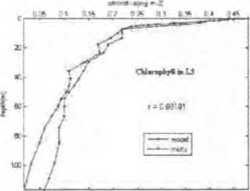
Figure 11 (a) The chl-a comparison between the model and in-situ (L3)
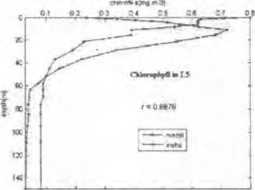
Figure 12 (a) The chl-a comparison between the model and in-situ (L5)

Figure 13 (a) The chl-a comparison between the model and in-situ (LB3)

Figure 10(b) The temp, comparison between the model and in-situ (Al)
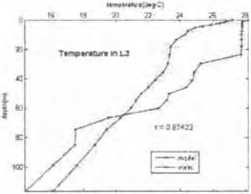
Figure 11 (b) The temp, comparison between the model and in-situ (L3)

Figure 12 (b) The temp, comparison between the model and in-situ (L5)

Figure 13 (b) The temp, comparison between the model and in-situ (LB3)
Lombok Strait and Adjacent Areas. Tokyo University of Marine Science and Technology. Department of Marine Information System Engineering. 2-1-6 Echujima, Kotoku, Tokyo 135-8533, Japan .
BehrenfeId, M. J., E. Boss, D. A. Siegel, and D. M. Shea. 2005. Carbon-based ocean productivity and phytoplankton physiology from space. Global Biogeochemical Cycles 19 Available at URL: http://www.icess.ucsb. edu/~davey/MyPapers/Behrenfeld_etal_GBC2004. pdf (25/01/2009).
Chaomin, S., L.S. Chin, and K.L. Keong. 2001. SeaWlFS Observation of Chlorophyll Distribution in Regional Seas. Centre for Remote Imaging, Sensing and Processing (CRISP). National University of Singapore. Singapore.
Hendiarti, N., H. Siegel and T Ohde. 2004. Investigation of different coastal processes in Indonesian waters using SeaWiFS data. Deep Sea Research Part II: Topical Studies in Oceanography 51 (1-3): 85-97, January-February 2004, Views of Ocean Processes from the Sea-viewing Wide Field-of-view Sensor (SeaWiFS) Mission: Volume 1. Elsevier Ltd.
Moisan,J.R., TA. Moisan, and M.R. Abbott. 2001. Modelling the Effect of Temperature on the Maximum Growth Rates OfPhytoplankton Populations. College of Oceanic and Atmospheric Science. Oregon State University. USA.
Available at URL: http: ∕/roms.mpl.ird.fr/papers/BGC-model.pdf (27/12/08).
Pertami, N. D. 2006. Study on The Vertical Distribution of Chlorophyll in Coastal Ocean; Development of Vertical Model Function at Western Sumbawa Sea (Thesis). Denpasar: Master Program of Environmental Science, Postgraduate Program. Udayana University.
Schiettecatte, L.S., F. Gazeau, C. V. Zee, N. Brion, and A. V Borges. 2006. Time series of the partial pressure of carbon dioxide (2001-2004) and preliminary inorganic carbon budget in the Scheldt plume (Belgian coastal waters). Geochemistry Geophysics Geosystems 7 (6).
Stewart, R. 2009. Distribution of Plankton. Oceanography in the 21st century- an online textbook. Available at http:/∕ oceanworld.tamu.edu/resources/oceanography-book/ phytoplanktondistribution.htm (11/04/09).
Susanto, R. D. andj. Marra. 2005. Effect of the 1997/98 El Nino on Chlorophyll a Variability Along the Southern Coasts of JavaandSumatra. Oceanography, 18 (4): 124- 127.
TubaIawony, S. 2001. Pengaruh Fakltor-Faktor Oseanografi Terhadap Produktivitas Primer Perairan Indonesia. Makalah Falsafah Sains. Program Pasca Sarjana/S3. Institut Pertanian Bogor. Available at URL: http://wwrw.rudyct.com/ PPS702-ipb/02201/simon_t.htm
36
Discussion and feedback